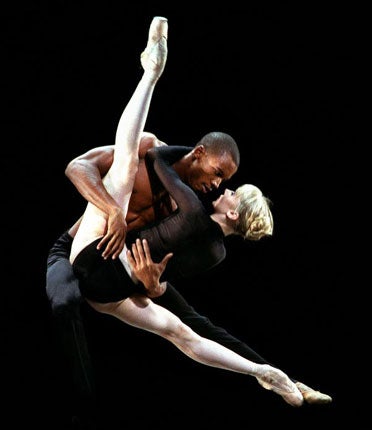Royal Ballet, Royal Opera House, London<br/>Rambert Dance Company, Sadler's Wells, London
Monica Mason's choice of Wayne McGregor as the Royal's house choreographer bears its first fruit

Your support helps us to tell the story
From reproductive rights to climate change to Big Tech, The Independent is on the ground when the story is developing. Whether it's investigating the financials of Elon Musk's pro-Trump PAC or producing our latest documentary, 'The A Word', which shines a light on the American women fighting for reproductive rights, we know how important it is to parse out the facts from the messaging.
At such a critical moment in US history, we need reporters on the ground. Your donation allows us to keep sending journalists to speak to both sides of the story.
The Independent is trusted by Americans across the entire political spectrum. And unlike many other quality news outlets, we choose not to lock Americans out of our reporting and analysis with paywalls. We believe quality journalism should be available to everyone, paid for by those who can afford it.
Your support makes all the difference.Sometimes the unlikeliest people come up with the wildest ideas. Dame Monica Mason's appointment of Wayne McGregor – a cybergeek who grew up without going near a ballet class – to a post once filled by Frederick Ashton and Kenneth MacMillan might have seemed counterintuitive. But Mason knew success when she saw it. And Chroma, McGregor's last work for the Royal Ballet two years ago, was the most dangerously thrilling thing to have happened on the Opera House stage in years.
So McGregor's first main-stage work as house choreographer has had plenty to prove – and not just that he is capable of producing another hit. It matters almost more that the company's dancers are fired up by association. The opening moments of Infra make it dazzlingly clear that they are.
Is Edward Watson a man or a snake? As he undulates in vermian waves, it's scarcely credible that this is the torso that assumed such princely rectitude in last month's Swan Lake. As Marianela Nuñez ducks and kicks and fidgets, her lush Manon is a distant memory. And who is that girl whose legs, cranked into half past twelve and then some (to an audible gasp from the house), that girl who curls into a blonde ball in the arms of the ever-more-splendid Eric Underwood? It's newbie Melissa Hamilton, normally a lowly member of the corps. McGregor's iconoclasm acts as a heat-seeking missile, zoning in on talent.
What is less expected is the new work's emotional content, a note of gentleness, and even a scrap of a story. Forming a virtual walkway over the dancer's heads is a screen along which march a mesmerising, never-ending trail of the artist Julian Opie's luminous pin figures. Some carry shopping or a briefcase, but they are faceless, sightless, oblivious. Below them, the flesh-and-blood figures engage in tense, twitchy couplings. Some suggest outright strife. Others look equable, until they too descend into struggle. Partners divide and pair off differently; at one point, there are six couples grappling in a line across the front of the stage. Each demands an attention you can't give it. Individuals blur into the mass.
The defining moment comes as Lauren Cuthbertson, left alone, kneels distressed centre-stage and a rush-hour load of real-life, ordinarily dressed people surge past her, unseeing. On and on they come – we must be seeing the entire Royal Ballet tramp past – as Max Richter's score for string quintet and distant shortwave radio crackle rises to its melancholy climax. The pity is that this surprisingly elegiac, supremely accessible work is down for so few performances. By the time you read this, there will be only three left to go, plus a screening on BBC2, though this alas will not include the two other pieces on this bill: Glen Tetley's gorgeously grand Voluntaries, set to Poulenc's earth-shuddering organ concerto; and Fleming Flindt's grimly comic The Lesson, in which a too-confident ballet bunhead gets her grisly comeuppance.
Rambert too has been putting its neck on the block with an ambitious new commission. Choreographed by director Mark Baldwin, Eternal Light is conceived for orchestra, two choirs and the company's entire quotient of dancers – a multi-discipline requiem for our times, ecumenical (of course), and even a touch agnostic.
Howard Goodall's score is as plumply English as warm beer and village green: lushly orchestrated and larded with tunes you can hum. At times, the Anglican tug of silvery children's voices brings a lump to the throat. But the tone is too crossover-pop to stay on the right side of sentimental. The visual element, too, swings between poles of taste. I loved the simple opening and closing image of a Mowgli-like figure, wheeling in darkness. But the girl dressed as a giant toucan has surely escaped from some other ballet, and the Remembrance Day Dies Irae, ranks of glittering diamanté crosses descending from the roof, looked as if it belonged on a Christian Lacroix catwalk.
Royal Ballet triple bill: 19, 20 and 26 Nov (020-7304 4000). The "Infra" documentary is on BBC2, 22 Nov, 8pm. Rambert: Plymouth Theatre Royal (01752 267222) 26-29 Nov
Join our commenting forum
Join thought-provoking conversations, follow other Independent readers and see their replies
Comments